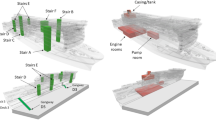Abstract
This paper promotes a discussion about evacuation models and their relation with evacuation processes. For this reason, the question “quo vadimus” (i.e., from Latin: where are we going to?) intends to initiate this discussion. Therefore, a brief overview of the importance of the evacuation modelling analysis within the Fire Safety Engineering (FSE) context is presented. This paper also presents an analysis of the evacuation modelling process and some remarks on how the evacuation models' reviews are being done as well. Furthermore, along with the previous question, some other subsequent key-questions can be aroused and this paper intends to analyse them, namely: Do we need the evacuation models for understanding evacuation processes? Are we doing the evacuation models' reviews properly? Do we understand well the evacuation models? Do we understand the evacuation modelling process?





Similar content being viewed by others
References
Tavares RM, et al (2008) The use of a mathematical multicriteria decision-making model for selecting the fire origin room. Build Environ. doi:10.1016/j.buildenv.2007.12.010
Bryan JL (2002) A selected historical review on human behaviour in Fire. Fire Protection Engineering Magazine, SFPE, number 16
Ko et al (2006) Trial evacuation of an industrial premises and evacuation model comparison. Fire Safety J. doi:10.1016/j.firesaf.2006.07.001
Galea ER (2003) PED 2003—Pedestrian and evacuation dynamics. Proceedings of the 2nd International Conference; CMS Press, ISBN No. 1-904521-08-8; p V
Fahy (2002) Tools for the simulation of human behaviour. Fire Protection Engineering Magazine, SFPE, number 16
The SFPE Handbook of fire protection engineering (3rd edn. pp 3-367–3-380). Bethesda, MD: Society of Fire Protection Engineers. Chapter 3 3–13 Movement of People: The Evacuation Timing, Guylene Proulx Chapter 3 3–14 Emergency Movement, Harold E. “Bud” Nelson & Frederick W. Mowrer
Song W-G, et al (2006) Evacuation behaviours at exit in CA model with force essentials:a comparison with social force model. Physica A 371:658–666. doi:10.1016/j.physa.2006.03.027
Friedman R (1992), An international survey of computer models for fire and smoke. J Fire Prot Eng 4(3):81–92. doi:10.1177/104239159200400301
Olenick SM, Carpenter DJ (2003) An updated international survey of computer models for fire and smoke. SFPE J Fire Prot Eng 13(2):87–110. doi:10.1177/1042391503013002001
Santos G, Aguirre BE (2004) A critical review of emergency evacuation simulation models. Disaster Research Center, University of Delaware NIST Workshop on Building Occupant Movement during Fire Emergencies June 9–10
Kuligowski, E. D. (2003) Modelling building evacuation: a review of issues in theory and application. NIST Spect Publ (in press)
Gwynne S, et al. (1999) A review of the methodologies used in the computer simulation of evacuation, the built environment. Build Environ 34:741–749. doi:10.1016/S0360-1323(98)00057-2
Gwynne JM (1987) Computer models for evacuation analysis. Fire Safety J 12(3):237–245
Sime J (1992) Human behaviour in fires summary report. CFBAC Report No.450, Portsmouth Polytechnic
Kisko TM, Francis RL (1986) Evacnet+, a building evacuation computer program. Fire Technol 22(1):75–76. doi:10.1007/BF01040247
Okasaki S, Matsushita S (1993) A study of simulation model for pedestrian movement with evacuation and queuing. In: Smith RA, Dickie JF (eds) Engineering for crowd safety, Elsevier, pp 271–280
Thompson PA, Marchant EW (1995) Testing and application of the computer model ‘Simulex’. Fire Safety J 24:149–166. doi:10.1016/0379-7112(95)00020-T
Ketchell N et al (1993) The EGRESS code for human movement and behaviour in emergency evacuations, Engineering for crowd safety, Institution of Civil Engineers, London, 17–18 March
Galea ER, Validation of evacuation models. Paper No. 97/IM/22. CMS Press, University of Greenwich, Greenwich
Sime JD (1994) Escape behaviour in fires and evacuations. In: Stallord P, Johnston L (eds) Design against fire: an introduction to fire safety engineering design. E & FN SPON, London
Pan X (2006) Computational modeling of human and social behaviors for emergency egress analysis. Ph.D. Thesis, Stanford University, USA
Fahy RF, Proulx G (1996) A study of occupant behavior during the world trade center evacuation. Conference proceedings of the seventh international interflam conference, Interscience Communications Ltd., London, pp 793–802
Teknomo K (2002) Microscopic pedestrian flow characteristics: development of an image processing data collection and simulation model. Ph.D. Thesis, Tohoku University, Japan
Drysdale D (1985) An introduction to fire dynamics. Wiley, New York, ISBN 047190613
Karlsson B, Quintiere JG (2000) Enclosure fire dynamics. CRC Press, Boca Raton, ISBN 0849313007
Author information
Authors and Affiliations
Corresponding author
Rights and permissions
About this article
Cite this article
Tavares, R.M. Evacuation Processes Versus Evacuation Models: “Quo Vadimus”?. Fire Technol 45, 419–430 (2009). https://doi.org/10.1007/s10694-008-0063-7
Received:
Accepted:
Published:
Issue Date:
DOI: https://doi.org/10.1007/s10694-008-0063-7




